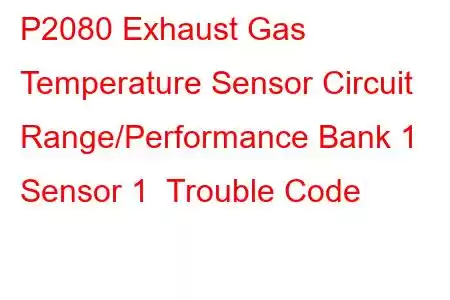P2080 EGT Sensor Circ Performance Bank 1 Sensor 1
OBD-II Trouble Code Technical Description
Exhaust Gas Temperature EGT Sensor Circuit Range/Performance Bank 1 Sensor 1
What does that mean?
This is a generic powertrain code, which means it applies to most makes/models, 1996-newer. Brands may include Ford, Dodge / Ram, Mercedes-Benz, Alfa Romeo, GMC, Chevrolet, Smart, VW, Audi, etc. However, specific troubleshooting steps will vary depending on the vehicle.
This diagnostic trouble code (DTC) P2080 refers to the condition of the EGT (exhaust gas temperature) sensor located in the "up" pipe forward of the catalytic converter. Its sole purpose in life is to protect the converter from damage due to excessive heat.
Code P2080 denotes a detected out of range or performance problem within the EGR temperature sensor circuit on bank 1, sensor #1. This P2080 DTC refers to Bank #1 (which is the side of the engine that contains cylinder #1).
An EGT sensor is found on most late model gas or diesel engines. It's nothing more than a heat sensitive resistor that converts the temperature of the exhaust into a voltage signal to the computer. It receives a 5-volt signal from the computer through one wire while the second wire is ground.
Example of an EGT exhaust temperature sensor:
The higher the exhaust temperature the less resistance to ground resulting in a higher voltage -- conversely, the lower the temperature the more the resistance resulting in lower voltage. If the engine senses a low voltage, the computer will vary the engine's timing or fuel ratio to keep the temperature in acceptable ranges within the converter.
In a diesel, the EGT is used to determine the timing of regeneration of the DPF (diesel particulate filter) based on the temperature rise.
If a catless up pipe has been installed along with the removal of the catalytic converter, there is normally no provision for the EGT, or if there is it won't function correctly without the back pressure. This will set the code.
Symptoms
The check engine light will illuminate and the computer will have set the code P2080. No other symptoms will be readily recognizable.
Potential Causes
The causes for this DTC may include:
Check for loose or corroded connectors or terminals, which is often the case Broken wires or missing insulation may be causing a short directly to ground The sensor may have failed A catback exhaust system without EGT provisions installed It's possible, although not probable, that the computer has failedP2080 Repair Procedures
Raise the vehicle and locate the sensor. For this code, it refers to the Bank 1 sensor, which is the side of the engine that contains cylinder #1. Its between the exhaust manifold and the converter or, in the case of a diesel, before the Diesel Particulate Filter (DPF). It looks different from the oxygen sensors in that is just a plug with two wires. A vehicle with a turbo will have the sensor next to the turbo exhaust input. Check the connectors for any abnormality such as corrosion or loose terminals. Follow the pigtail up to its connector and check that one as well. Look for signs of missing insulation or bare wires that may be shorting to ground. Disconnect the upward connector and remove the EGT sensor. Check the resistance with an ohmmeter. Probe both terminals in the connector. A good EGT will have about 150 ohms. If there is very little resistance -- below 50 ohms replace the sensor. Use a hair dryer or heat gun and heat the sensor while you watch the ohmmeter. The resistance should drop as the sensor is heated and rise as it cools. If not, replace it. If all was good to this point, turn the key on and measure the voltage at the engine side of the pigtail. There should be 5 volts at the connector. If not replace the computer.Another reason for this code to set is if the
Read: 31


